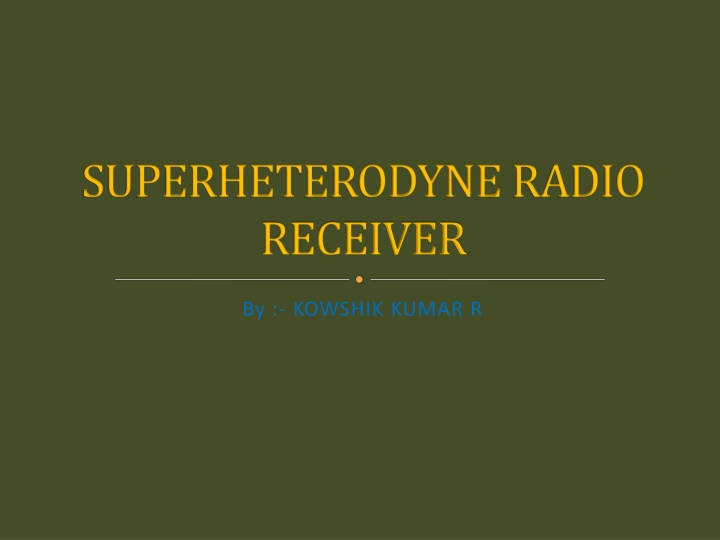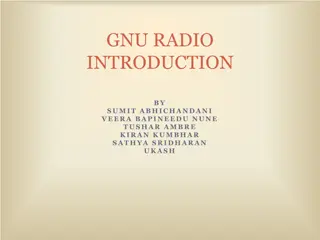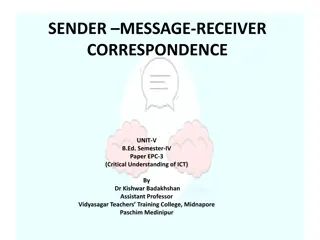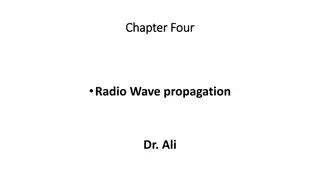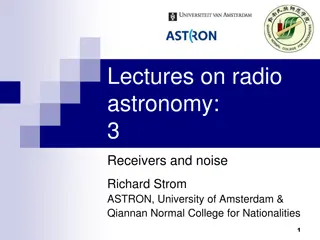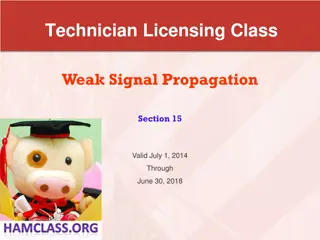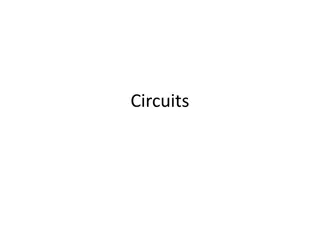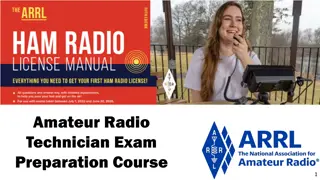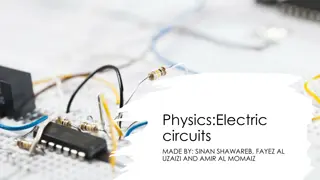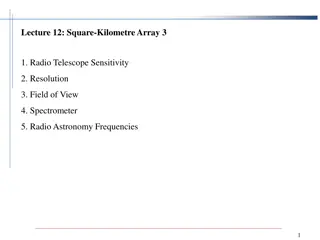Introduction to Superheterodyne Radio Receiver Circuits
Superheterodyne radio receiver circuits operate based on heterodyne or frequency mixing principles. These circuits involve using a local oscillator to mix the incoming signal with a sine wave, shifting it to an intermediate frequency (IF) for further processing and demodulation. The design includes components like a receiving antenna, tuned stages, a mixer, filters, and amplifiers to extract and recreate the original information from radio signals efficiently. The block diagram and circuit descriptions highlight the front-end amplifier, tuning block, local oscillator, and mixer stages crucial for receiving and processing radio signals effectively.
Download Presentation

Please find below an Image/Link to download the presentation.
The content on the website is provided AS IS for your information and personal use only. It may not be sold, licensed, or shared on other websites without obtaining consent from the author.If you encounter any issues during the download, it is possible that the publisher has removed the file from their server.
You are allowed to download the files provided on this website for personal or commercial use, subject to the condition that they are used lawfully. All files are the property of their respective owners.
The content on the website is provided AS IS for your information and personal use only. It may not be sold, licensed, or shared on other websites without obtaining consent from the author.
E N D
Presentation Transcript
SUPERHETERODYNERADIO RECEIVER By :- KOWSHIK KUMAR R
electronics frequency mixing intermediate frequency radio Edwin Armstrong War I "Super heterodyne" is a contraction of "supersonic heterodyne", where "supersonic" indicates frequencies above the range of human hearing. The word heterodyne is derived from the Greek rootshetero- "different", and - dyne "power".
Design and Principle of Operations. The principle of the Super heterodyne receiver depends on the use of heterodyne or frequency mixing. The Signal from the antenna is filtered sufficiently at least to reject the image frequency and possibly amplified. A local oscillator in the receiver produces a sine wave, which mixes with that signal, shifting it to a specific intermediate frequency (IF),usually a lower frequency. The IF signals is itself filtered and amplified and possibly processed in additional ways. The demodulator uses the IF signal rather than the original radio frequency to recreate a copy of the original information. The common elements of a Super heterodyne receiver circuits is A Receiving Antenna ; A Tuned stage, which optionally contain amplifications; a variable frequency local oscillator; a frequency mixer; a band pass filter and intermediate frequency amplifier and a demodulator plus additional circuitry to amplify or process the original audio signal.
BLOCK DIAGRAM OF A TYPICAL SUPERHETERODYNE RADIO RECEIVER http://upload.wikimedia.org/wikipedia/commons/thumb/8/88/Superhet2.svg/497px-Superhet2.svg.png
CIRCUIT DESCRIPTION FRONT END AMPLIFIER AND TUNING BLOCK To receive a radio signal a suitable antenna is required. Signal enter the front end circuitry from the antenna. This circuit block performs two main functions. TUNING:- Broad band tuning is applied to RF (radio frequency)stage. The purpose of this to reject the signals on the image frequency and accept those on the wanted frequency. It must also be able to track the local oscillator so that as the receiver is tuned, so the RF tuning remains on the required frequency. Typically the selectivity provided at this stage is not high. Its main purpose is to reject signals on the image frequency which is at a frequency equal to twice that of the IF away from the wanted frequency. AMPLIFICATION:- In amplification, the level is carefully chosen so that it does not overload the mixer when strong signals are present. But enables the signals to be amplified sufficiently to ensure a good signal to noise ratio is achieved. The amplifier must also be a low noise design.
LOCAL OSCILLATOR AND MIXER The signal is then fed into a circuit where it is mixed with a sine wave from a variable frequency oscillator known as the LOCAL OSCILLATOR(LO). The mixer uses a non-linear component to produce both sum and difference beat frequencies signals, each one containing the modulation contained in the desired signal. The output of the mixer may include the original RF signal at fRF, the local oscillator signal at fLO, and the two new heterodyne frequencies fRF+ fLO and fRF fLO. IF band pass filter removes all but the desired IF signal at fIF. The IF signal contains the original modulation that the received radio signal had at fRF. The frequency of the local oscillator fLO is set so the desired reception radio frequency fRF mixes to fIF . There are two choices for the local oscillator frequency because the dominant mixer products are at fRF fLO . If the local oscillator frequency is less than the desired reception frequency. It is called LOW SIDE INJECTION (fIF= fRF fLO). If the local oscillator is higher, then it is called HIGH SIDE INJECTION (fIF= fLO fRF).
fRF+ fIF If fLO is set to then an incoming radio signal at fLO+ fIFwill also produce a heterodyne at fIF . This is called the image frequency and must be rejected by the tuned circuits in RF stage. The image frequency is 2 fIFhigher than fRF , so employing a higher IF frequency fIF increases the receivers image rejection without requiring additional selectivity in RF stage. To suppress the unwanted image the tuning of the RF stage and LO may need to track each other. The tracking can be done with a multi section variable capacitor some varactors driven by a common control voltage. A RF amplifier may have tuned circuits at both its input and its output. So three or more tuned circuits may be tracked. In practice the RF and LO frequencies need to track closely but not perfectly.
INTERMEDIATE FREQUENCY AMPLIFIER The stages of an intermediate frequency amplifier are tune to a fixed frequency that does not change as the receiving frequency changes. The IF amplifier is selective around its center frequency fIF . Typically the IF center frequency fIF is chosen to be less than the desired reception frequency fRF . The choice has some performance advantages. FIRST, it is easier and less expensive to get high selectivity at a lower frequency , for the same bandwidth, a tuned circuit at a lower frequency needs a lower Q. stated another way, for the same filter technology a higher center stages to achieve the same selectivity bandwidth. SECOND , it is easier and less expensive to get high gain at a lower frequency. When used at high frequencies, many amplifiers show a constant gain-bandwidth product characteristic.
Usually the intermediate frequency is lower than the reception frequency fRF , but in some modern receivers a higher IF frequency is used to minimize problems with image rejection or gain the benefits of fixed tuned stages. In early superhet s ,the IF stage often a regenerative stage providing the sensitivity with fewer components, such superhet s were called super gainers or regenerodynes. To see how this operates in reality take the example of two signals, one at 6MHz and another at 6.1 MHz also take the example of IF situated at 1MHz. If the local oscillator is set to 5MHZ the two signals generated by mixer as a result of 6 MHz signal fall at 1MHz and 11MHz. Naturally the 11MHz signal is rejected , but the one at 1MHz pass through the IF stage. The signal at 6.1MHz produces a signal at 1.1MHz and this falls outside bandwidth of the IF, so the only signal to pass through the IF is that from the signal 6MHz.
BANDPASS FILTER The IF stage includes a filter &- or multiple tuned circuits in order to achieve the desired selectivity. This filtering must therefore have a band pass equal to or less than the frequency spacing between adjacent broadcast channels. Ideally a filter would have a high attenuation to adjacent channels, but maintain a flat response across the desired signal spectrum in order to retain the quality of the received signals. This may be obtained using one or more dual tuned IF transformers, a quartz crystal filter, or a multiple ceramic crystal filter.
DEMODULATION The received signal is now processed by the demodulator stage where the audio signal is recovered and then further amplified. AM demodulator requires the simple rectification of the RF signal, and a simple RC low pass filter to remove remnants of the intermediate frequency. Different demodulators are required for different types of transmission, and they include, AM Diode detector:- This is the most basic form of detector and this circuit block would simple consist of a diode and possibly a small capacitor to remove any remaining RF. The detector is cheap and its performance is adequate, requiring a sufficient voltage to overcome the diode forward drop. SYNCHRONOUS AM DETECTOR:- This form of AM detector block is used in where improved performance is needed. It mixes the incoming AM signal with another on the same frequency as the carrier.
SSB PRODUCT DETECTOR:- It consist of a mixer and a local oscillator, often termed a beat frequency oscillator( BFO) or carrier insertion oscillator(CIO). This form of detector is used for Morse code transmission where the BFO is used to create an audible tone in line with the one-off keying of the transmitter carrier. BASIC FM DETECTOR:- As an FM signal carries no amplitude variations a demodulator blocks that senses frequency variations is required. It should also be insensitive to amplitude variations as these could add extra noise. Simple FM detectors such as the foster seeley or ratio detectors can be made from discrete components although they do require the use of transformers. PLL FM DETECTOR:- A Phase locked loop can be used to make a good FM detector. The incoming FM signal can be fed into the reference input, and the VCO drive voltage used to provide the detected audio output. QUADRATURE FM DETECTOR:- This form of FM detector block is widely used within IC s . It simply to implement and provides good linear output.
AUDIO AMPLIFIER The output from the demodulator is the recovered audio. This is passed in to the audio stages where they are amplified and presented to the head phones or loud speakers.
ADVANTAGES AND DRAWBACKS OF THE SUPERHETERODYNE DESIGN Superheterodyne receiver have essentially replaced all previous receiver designs. The superhet receivers offers superior sensitivity, frequency stability and selectivity. Compared with the tuned radio frequency receiver design, superhet s offer better stability because tunable oscillator is more easily realized than a tunable amplifier. Operating at a lower frequency , IF filters can give narrower pass bands at the same Q factor than an equivalent RF filter. Regenerative and super regenerative receivers offered a high sensitivity. But often suffer from stability problems making them difficult to operate.
DRAWBACKS LOCAL OSCILLATOR RADIATION It is difficult to keep stray radiation from oscillator below the level that a nearby receiver can detect. The receivers local oscillator can act like a low power CW transmitter. Consequently, there can be mutual interference in the operation of two or more superhet receivers in close proximity. The method of significantly reducing the local oscillator radiation from the receivers antenna as to use an RF amplifier between the receivers antenna and its mixer stage.
